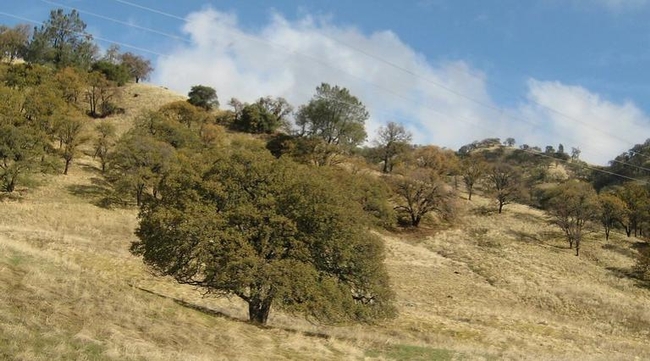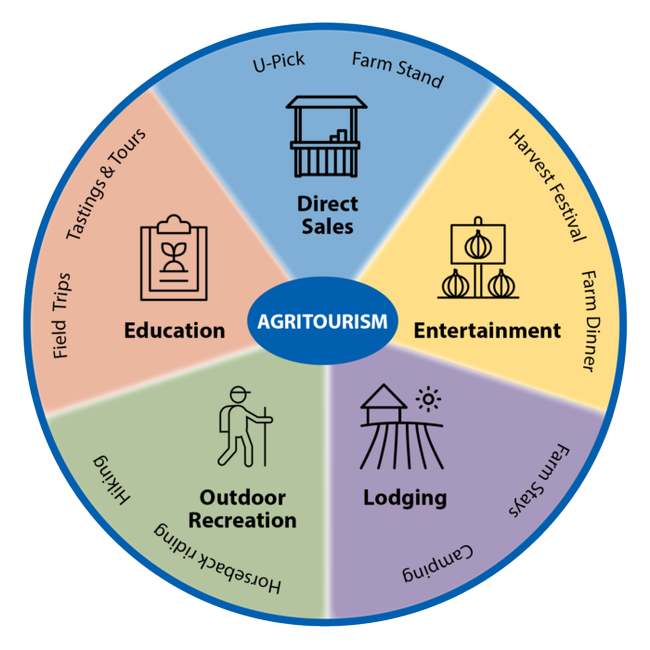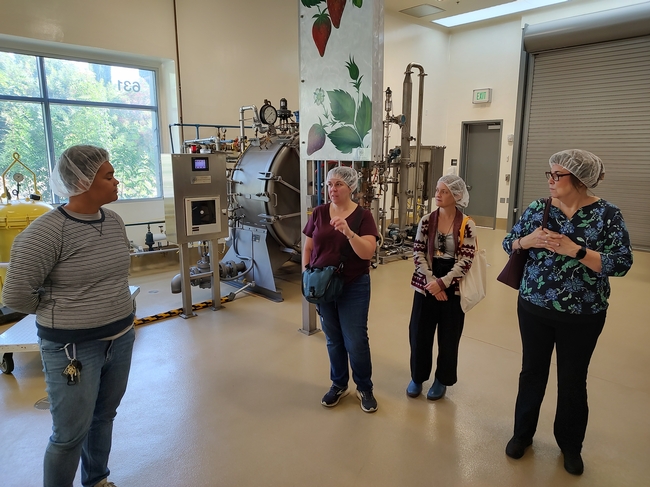- Author: Olivia Marie Quinlan Henry
- Contributor: Rachael Callahan
Image: California Department of Fish & Wildlife, CC BY 2.0.
This fall, UCCE Food Systems Advisor Olivia Henry worked with UC SAREP's Agritourism Coordinator Rachael Callahan and Alexis Koefoed of Pleasants Valley Agricultural Association to host a webinar on models of agritourism regulations across California. As defined by UC SAREP, agritourism is a commercial enterprise at a farm or ranch for the enjoyment of visitors that generates supplemental income. Agritourism activities include u-picks, farm stays, weddings, mountain biking and more. Many of these activities are not allowed in agriculturally zoned areas without being explicitly included in the relevant county or city code.
In March, Solano County planners floated the idea of creating an agritourism overlay for the Pleasants Valley, Lagoon Valley and Winters areas. Henry, Callahan and Koefoed wondered what creative policy ideas for supporting agritourism might apply to this corner of Solano County, where small farms and ranches line valleys at the base of low mountains. The webinar's six speakers came from Contra Costa, Santa Barbara and El Dorado counties — all places where agritourism regulations were recently adopted or updated. Speakers included representatives from the county and agritourism farmers that been active in the policy making process. The intent of the webinar was for both Solano County staff as well as local farmers to attend and learn about their role in the process. Learning from their peers, county staff heard about regulations that could potentially be adapted for Solano county, while farmers gained insights into how to engage with the county. You can watch a recording of the webinar or view slides.
Here are a few takeaways:
Developing regulations takes time.
Solano County farmers could expect to wait years before new agritourism rules are on the books. In Contra Costa County, the process began in 2016 at the urging of a county supervisor to look into ways to support the economic viability of agriculture. It was only in March 2024 when the Agritourism Ordinance was finally adopted by the Board of Supervisors. In Santa Barbara County, what is now called the Agriculture Enterprise Ordinance has been in the works since 2016. Even when policy is adopted, it may need to be regularly revised. That's the case with El Dorado County's Ranch Marketing Ordinance, which has been around in some form since the 1980s but has been regularly updated to better account for small farms, wineries and most recently challenges with on-farm weddings.
Educational events can fall into grey areas.
Attendees were asked which agritourism topics they were most interested in, and many people indicated they wanted to hear about how other counties' policies address on-farm educational experiences such as tours and classes. Santa Barbara's Agriculture Enterprise Ordinance exempts low-intensity “educational experiences” under a certain size from needing a permit, with larger and more frequent tours — as well as those taking place next to legacy crow crop properties — needing a conditional use permit. Neither the El Dorado or Contra Costa codes explicitly mention things like tours or classes, although the Ranch Marketing Ordinance does have specific requirements for “marketing events” in which farms offer special product sales or promotions. Speakers explained that, even if small educational events are in a regulatory grey area, their counties were most concerned about high-impact agritourism uses: events with lots of people, cars, noise and water use.
Regulating large events can be a challenge.
Big events can be a major revenue opportunity for farmers, but planners worry about traffic, effects on neighbors and other impacts in neighborhoods that weren't designed for large crowds. El Dorado County has a creative way to let neighbors know that big events are coming up nearby: the Ranch Marketing and Winery Event Data portal lists the date, location, hours and point of contact for special events. All that information has to be posted two weeks in advance. Still, Agricultural Commissioner LeeAnne Mila said complaints about weddings have increased to the point where she recently proposed a new permit requirement for farms to host special events. In Contra Costa County, one of the unique concerns around high-intensity agritourism uses is water. Principal Planner Jennifer Cruz explained that stress on groundwater resources was a major consideration during the policy development process. The final ordinance explicitly requires bed and breakfast establishments and farm-to-table restaurants to have a retail water supplier or be located within the boundaries of a specific groundwater sub-basin.
How do you make sure farming is the primary land use, not tourism?
The goal of agritourism is to help farms stay economically resilient, and that's what regulators say they want, too. But some speakers addressed the worry that making tourism activities allowable in agriculturally zoned areas will make entertainment the primary land use, not growing food. Rancher Guner Tautrim said that in Santa Barbara County, part of their strategy was to limit the scale and frequency of events to “a threshold to where it's helping the rancher but it's not making so much money that they're like, ‘Oh, I'm not even going to plant my crop.'”
In Contra Costa, the ordinance tries to address this concern by requiring that agritourism operators submit an “agricultural activities and promotion plan” with permit applications for uses like farm stays, farm dinners and farm-to-table restaurants. The plan has to demonstrate that the primary use of the land is for growing food, and should show how the use “will promote local agriculture and educate guests.”
In El Dorado County, Mila said she is concerned about “fake farms” that plant the required minimum acreage of crops – five acres of permanent cropland or ten acres of annual cropland — with the ultimate intent of running a wedding business and not a farm business. The current code allows those farms to host 24 special events per year without a land use permit. In an effort to reinforce the primacy of ag, Mila put forward revision to allow 12 special events per year with an administrative permit, and an additional two events allowed for every “confirmed additional 5 acres of crop cultivated and capable of producing a commercial crop” up to 24 events per year.
Agritourism regulations are zoning regulations – but other departments are involved, too
Agritourism regulations are fundamentally zoning regulations: rules that say what you can do on a given parcel of land. Zoning is the purview of planning departments, and these departments are usually the first stop for agritourism operators looking to find out if their project is allowable, and whether or not a land use permit is needed. But getting an agritourism enterprise off the ground means also working with other departments and jurisdictions. In Santa Barbara County, rancher Tautrim cautioned that supportive zoning regulations don't mean agritourism projects will be met with open arms by every regulator. He explained that environmental health departments might ask for septic systems, or fire departments might ask for sprinkler systems — all expensive investments that could scuttle a project. “A lot of these ideas we're coming up with [in the Agriculture Enterprise Ordinance] are not going to be viable for those of us without big pocketbooks to pay for these upfront costs.”
Image: UC SAREP
- Author: Olivia Henry
Pilot Plant manager Amy Fletcher talks with UCCE staff in front of a rotary steritort – which Fletcher likened to “an Instant Pot but faster” – that quickly brings canned, jarred or bottled food up to the lethal temperature for pathogens then rapidly cools the food down with cold water. Photo: Olivia Henry
Food processing – meaning any activity such as chopping, peeling, freezing, milling or preserving that makes raw food ready to eat – is a critical and sometimes overlooked part of the food system. At UC Davis, several food processing facilities within the Department of Food Science and Technology serve the university community as well as regional and international businesses. To learn more, staff members from UC Cooperative Extension (UCCE) Capitol Corridor and UCCE Placer-Nevada visited the California Processing Tomato Industry Pilot Plant and Carlos Alvarez Food Innovation Lab last month.
Pilot plant available for industry research
At the pilot plant, UCCE staff members learned how the 4,000-square-foot facility serves undergraduate education, academic research, university extension and food businesses. Those businesses have ranged from a five-person startup developing a poke recipe to multinational manufacturers such as Mars, Incorporated.
The facility can only be used for research purposes and not commercial production, plant manager Amy Fletcher explained. Much of the equipment would need to be retrofitted or replaced to process food under a retail food permit. For illustration, Fletcher pointed to the facility's Atlas Pacific Peach Pitter/Aligner, believed to be the oldest of its type in California.
While the pilot plant isn't a co-packer, “it's a great place to do a proof of concept [for a product],” Fletcher said. “For example, does a $2 million machine do what it says it's going to do before you buy it.”
More than a dozen machines and processing lines – including a freeze dryer, a lye line, a sorting line and flume washer – are available for use. The pilot plant stays busy with an undergraduate class using the facility plus university research projects on peaches, plums and tomatoes in the summer.
Food innovation lab busy with students, UC research
The Carlos Alvarez Food Innovation Lab is more heavily used by students, with classes using the lab four days a week. While the lab cannot be rented by outside groups like the pilot plant, it is available to UC affiliates as well as faculty who partner with food businesses to do consumer research. Lab manager Matthew Ford regularly hosts restaurant groups who are doing consumer testing as part of research partnerships.
Fletcher shows off a high-pressure processing (HPP) unit that is used to pasteurize food without heat. Its most common use is for refrigerated goods such as juice, hummus, guacamole and seafood. Photo: Olivia Henry
Food Innovation Lab Manager Matthew Ford talks with Sacramento Master Food Preserver Coordinator Wendi Weston. Photo: Olivia Henry






